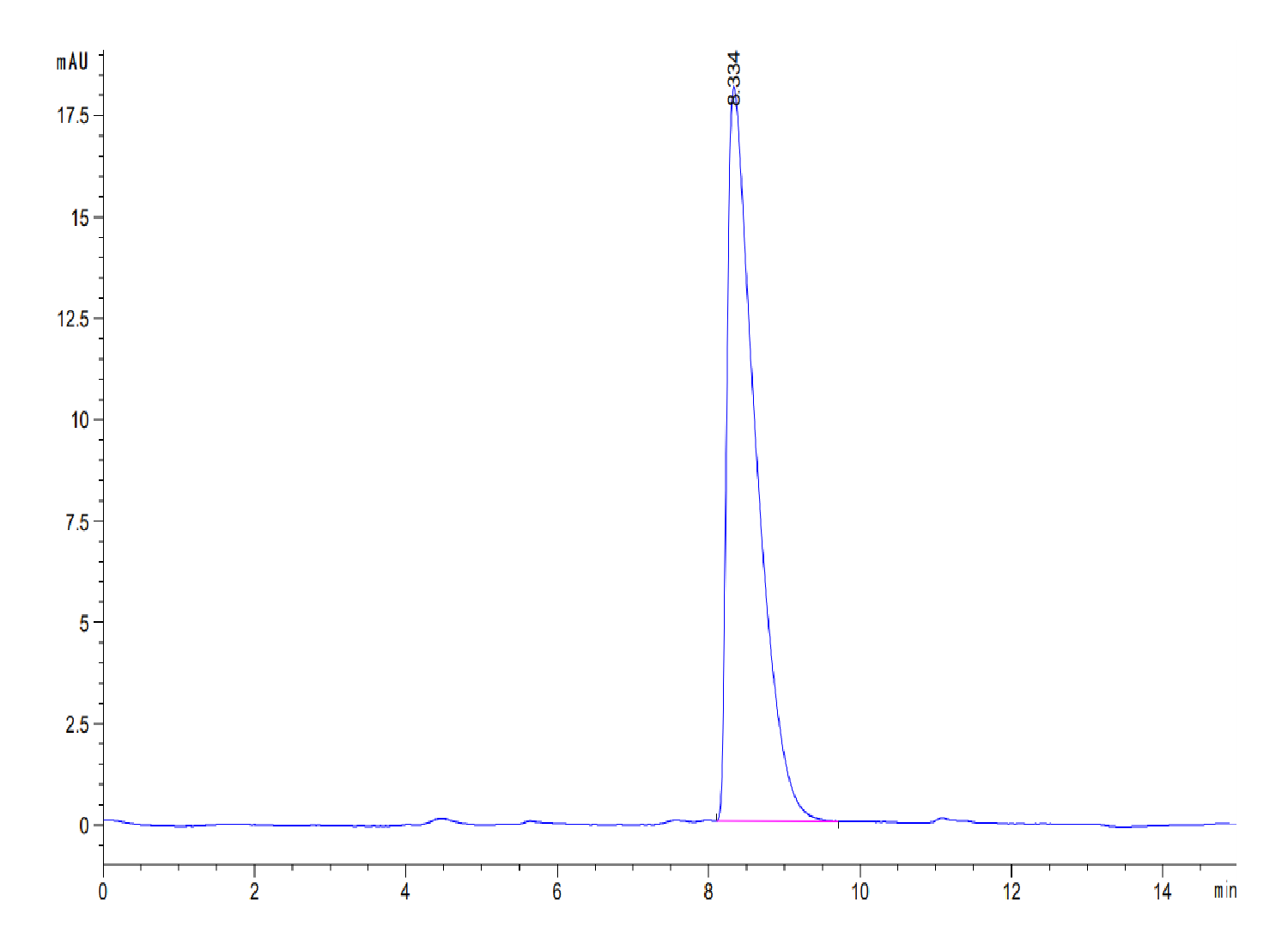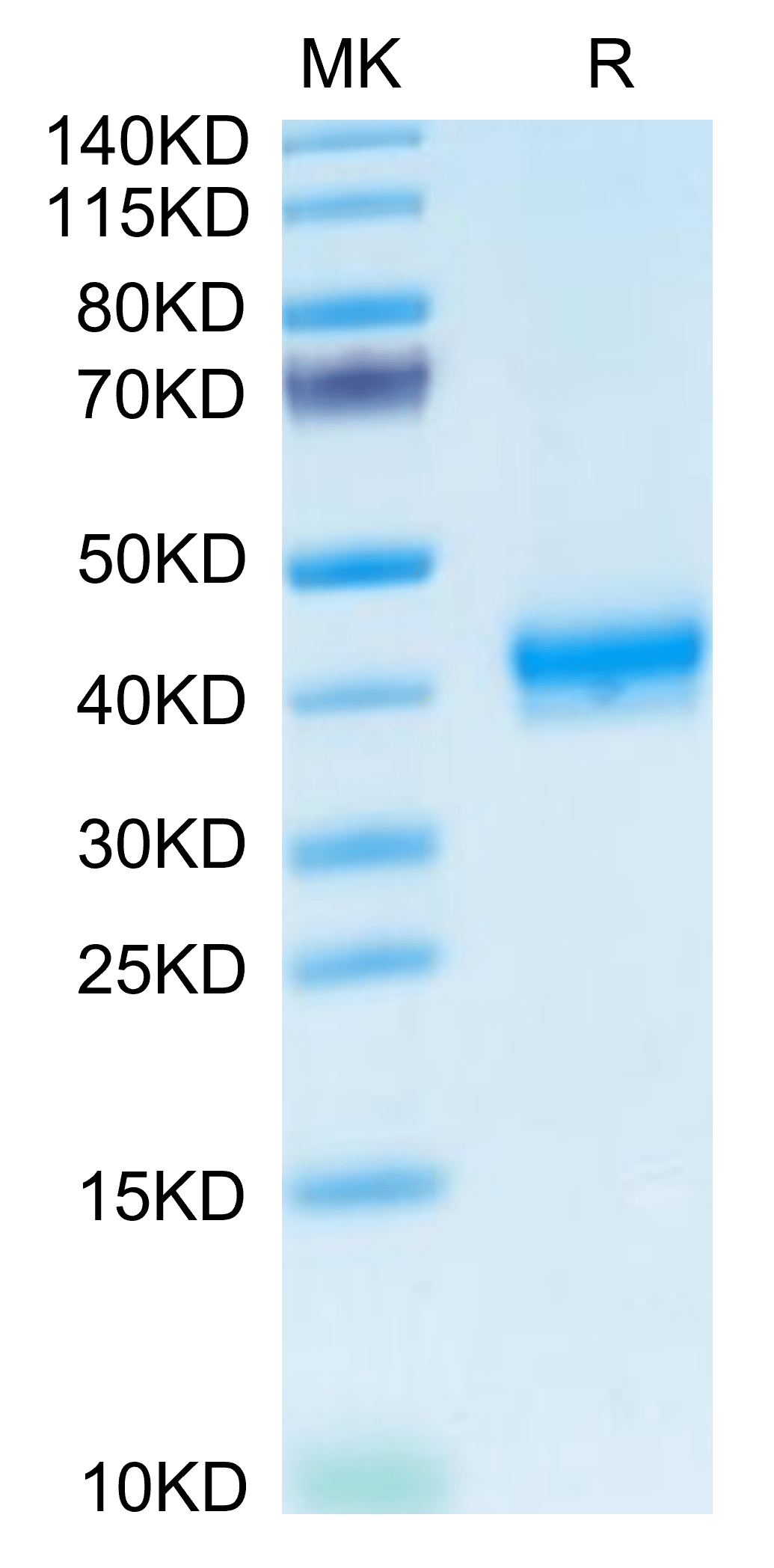| Weight | 1 lbs |
|---|---|
| Dimensions | 9 × 5 × 2 in |
| accession | Q8N126 |
| express system | HEK293 |
| product tag | C-His |
| purity | > 95% as determined by Tris-Bis PAGE;> 95% as determined by HPLC |
| background | Cell adhesion molecules belonging to the Cadm family, and in particular Cadm3 (axonal) and its heterophilic binding partner Cadm4 (Schwann cell), mediate these interactions along the internode.over-expressing Cadm3 on the surface of DRG neuron axons results in an almost complete inability by Schwann cells to form myelin segments. Axons of superior cervical ganglion (SCG) neurons, which do not normally support the formation of myelin segments by Schwann cells, express higher levels of Cadm3 compared to DRG neurons. |
| molecular weight | The protein has a predicted MW of 34.6 kDa. Due to glycosylation, the protein migrates to 38-45 kDa based on Tris-Bis PAGE result. |
| available size | 100 µg, 500 µg |
| endotoxin | Less than 1EU per μg by the LAL method. |
Human CADM3 Protein 3733
$300.00 – $1,000.00
Summary
- Expression: HEK293
- Pure: Yes (HPLC)
- Amino Acid Range: Asn25-Tyr329
Human CADM3 Protein 3733
| protein |
|---|
| Size and concentration 100, 500µg and lyophilized |
| Form Lyophilized |
| Storage Instructions Valid for 12 months from date of receipt when stored at -80°C. Recommend to aliquot the protein into smaller quantities for optimal storage. Please minimize freeze-thaw cycles. |
| Storage buffer Shipped at ambient temperature. |
| Purity > 95% as determined by Tris-Bis PAGE |
| target relevance |
|---|
| Cell adhesion molecules belonging to the Cadm family, and in particular Cadm3 (axonal) and its heterophilic binding partner Cadm4 (Schwann cell), mediate these interactions along the internode.over-expressing Cadm3 on the surface of DRG neuron axons results in an almost complete inability by Schwann cells to form myelin segments. Axons of superior cervical ganglion (SCG) neurons, which do not normally support the formation of myelin segments by Schwann cells, express higher levels of Cadm3 compared to DRG neurons. |
| Protein names Cell adhesion molecule 3 (Brain immunoglobulin receptor) (Immunoglobulin superfamily member 4B) (IgSF4B) (Nectin-like protein 1) (NECL-1) (Synaptic cell adhesion molecule 3) (SynCAM3) (TSLC1-like protein 1) (TSLL1) |
| Gene names CADM3,CADM3 IGSF4B NECL1 SYNCAM3 TSLL1 UNQ225/PRO258 |
| Protein family Nectin family |
| Mass 9606Da |
| Function Involved in cell-cell adhesion. Has both calcium-independent homophilic cell-cell adhesion activity and calcium-independent heterophilic cell-cell adhesion activity with IGSF4, NECTIN1 and NECTIN3. Interaction with EPB41L1 may regulate structure or function of cell-cell junctions (By similarity). |
| Catalytic activity #N/A |
| Subellular location Cell membrane ; Single-pass type I membrane protein. Cell junction . |
| Tissues Isoform 1 is expressed mainly in adult and fetal brain. Isoform 2 is highly expressed in adult brain and weakly expressed in placenta. In brain, Isoform 2 is highly expressed in cerebellum. |
| Structure Homodimer. Can form trans-heterodimers with NECTIN3. Interacts with EPB41L1, DLG3, PALS2 and CASK (By similarity). |
| Domain Th |
| Target Relevance information above includes information from UniProt accession: Q8N126 |
| The UniProt Consortium |
Data
 |
| The purity of Human CADM3 is greater than 95% as determined by SEC-HPLC. |
 |
| Human CADM3 on Tris-Bis PAGE under reduced condition. The purity is greater than 95%. |
Publications
Publications
| pmid | title | authors | citation |
|---|---|---|---|
| We haven't added any publications to our database yet. | |||
Protocols
| relevant to this product |
|---|
Documents
| # | ||
|---|---|---|
| Please enter your product and batch number here to retrieve product datasheet, SDS, and QC information. | ||














